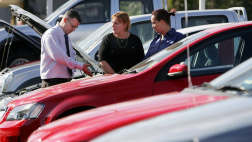One Australian car cut through the 1970s cultural cringe of Farrah Fawcett hairstyles, tan-coloured flared trousers and looking cool with a cigarette.
Chrysler's Valiant Charger was hip, possibly even hop, and the colourful dancing graphics of magazine advertising and the monochrome TV ads of smiling kids and a hairy Graeme Blundell flashing the "V" sign with their fingers, shouting "Hey Charger", was addictive.
In retrospect, the corny - and blatantly sexist - TV ads were extremely successful in relaying the fun aspect of the car that singularly lifted Chrysler's Australian image onto a higher plane.
Despite the intervening decades, that addiction lingers. Charger owners' clubs are firmly entrenched in our capital cities, the cars are loved and paraded and the market prices are as strong as a Hemi six.
John Urquhart caught the Charger bug at age 33, buying a new R/T in early 1972 - the build date was September 1971 - for about $3600. After 39 years, he still has it.
"I bought it because I intended it for motor racing," says the retired lawyer now living the quiet life in country south-west WA. "But it became the family car right up to the 1980s and I never entered it in an event until 1991. It really lives up to its name - R/T for road and track - because it was comfortable and roomy for my two children as they grew up."
The beige coupe with its blacked-out bonnet panels, pressed steel wheels finished in graphite to look like alloys, the golf-club head gear knob and serious "265 R/T" badges is as aesthetic today as it was when Chrysler Australia penned the body shape atop a chopped sedan platform.
Urquhart pressed it into service in 1991, entering hill climbs, sprints and regularity trials and campaigning it around the country venues and even using it to trailer his other car - an open wheeler - to eastern states events. These include a Mopars on the Murray show and Shannons' 2001 National Motoring Tour.
"I remember I drove it to Adelaide for a supporting race for open wheelers that preceded the main event at the 1985 Adelaide Grand Prix, the first one," he says.
"On the way home (to Perth), the Charger turned over 100,000 miles. It's now done 145,500 miles since new."
The Charger is original down to its number plate, but hasn't been free of incidents. A bushfire in 2006 that devastated forests around Urquhart's home destroyed the sheds - but left the house intact - in which the Charger was stored, damaging the car.
Later, a following motorist in the city failed to stop in time and wrote off her small car on the back of the Charger. You can still see the scratch in the Charger's rear chrome bumper but the minor sheetmetal damage has been repaired and the tail light replaced.
The 265 (for cubic inches which is 4.3 litres) "Hemi" six has a new block - though Urquhart still has the original - and there are extractors with 2-inch pipes, a meatier cam profile and the Carter carburettor has been replaced with a Holley 500. The original three-speed manual gearbox has given way to a four-speed box.
Dyno testing shows it has 163kW at the flywheel and 123kW at the wheels at 4950rpm, just shy of the engine's 5000rpm redline.
"I had power brakes fitted. It doesn't stop any better, but the pedal pressure is a lot less," Urquhart says.
"It has also had the steel members replaced around the steering box. It is a common problem that this area is weak and prone to rust, so it's now reinforced."
Like most Chrysler enthusiasts, Urquhart remains a member - he was one of its originals - of the Charger Club of WA.
So he knows its value and now indicates the car could be for sale. "I retired from events in June," he says.
"So the car won't be used much now. I estimate it's worth $47,500 and I was analytical in arriving at that because when new it was about half the price of a Bathurst-specced Charger that are now going for $80,000-$90,000.
"I'm not desperate to sell it - it's been a part of my and my family's life for 40 years - but I may let it go."
HISTORY
Chrysler Australia built the emotive Valiant Charger from 1971 to 1978, creating a coupe body from the A-pillar back on top of a VH sedan platform and chopping 152mm out of the wheelbase. It was also 333mm shorter than the sedan and 54kg lighter at 1352kg.
The first VH series of the Charger was the most popular. It was a sell-out in Australia and also in New Zealand where it was assembled from imported kit components.
The VH Valiant Charger won the 1971 Australian "Wheels Car of the Year" Award.
The Charger R/T and Charger 770 shared the 265 "HP" (high performance) two-barrel carburettor six-cylinder Hemi engine. The optional E37 had a tuned "Six Pack" version of the engine with triple sidedraught Weber carburettors. There was a further tuned version, option E38, which was the basis of Chrysler's touring car racer for 1971. The E38 had 209kW and added $580 to the 1971 purchase price.





.jpg)
.jpg)

.jpg)
_0.jpg)


.jpg)

















.jpg)
.jpg)




.jpg)
.jpg)




